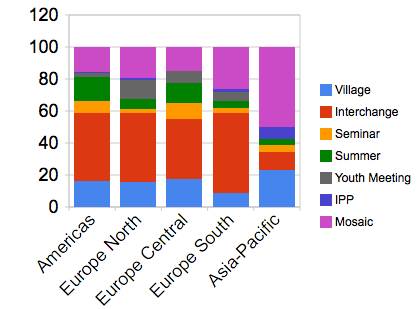Bebe sent me some statistics the other day on hosting trends in the past 5 years, so I started digging into them, because I was wondering, whether all regions like to host the same kind of porgamms.

In this graph you can see, which programmes were hosted by the respective regions in 2008. percentage-wise. I should also add the absolute numbers of camps hosted to give a better picture:
Americas: 97
Europe North: 77
Europe Central: 40
Europe South: 100
Asia-Pacific: 26
A few things are interesting:
- Youth Meeting remains pretty much a "European thing".
- Asia-Pacific is very weak in Interchanges. This is sad, because I can see a huge potential for a cultural experience here.
- Mosaics seem to have caught on in the Asia-Pacific region pretty well. However, I think the Mosaic information distorts this graph a bit - simply by size and effort, I'm not sure they can be compared with the other programmes.
- In percent, Europe South hosts the least amount of villages but runs the most interchanges.

In this graph you can see, which programmes were hosted by the respective regions in 2008. percentage-wise. I should also add the absolute numbers of camps hosted to give a better picture:
Americas: 97
Europe North: 77
Europe Central: 40
Europe South: 100
Asia-Pacific: 26
A few things are interesting:
- Youth Meeting remains pretty much a "European thing".
- Asia-Pacific is very weak in Interchanges. This is sad, because I can see a huge potential for a cultural experience here.
- Mosaics seem to have caught on in the Asia-Pacific region pretty well. However, I think the Mosaic information distorts this graph a bit - simply by size and effort, I'm not sure they can be compared with the other programmes.
- In percent, Europe South hosts the least amount of villages but runs the most interchanges.

I'm just wondering to know countries like Egypt, Jordan and Lebanon, in what category are they counted as?
interesting statistics (and I agree about the mosaic distorting the graph) :)
Egypt, Jordan and Lebanon all are listed as "Europe South". A bit imperialistic, I guess.
It would be interesting to see not the number of programmes hosted, but the number of participants that go through any kind of programme (then, I think, Mosaic would not be that distorting...)
I think this shows the connection between hosting and practical logistics rather than educational purpose. I think Interchange and Mosaic are extremely popular not only for the program, but for its logistical benefits. Interchange makes a lot of money for chapters; Mosaic isn't expensive and doesn't involve missing school; Village is harder to host if there are any security concerns. It makes me wonder if we feel some programs are more effective in promoting our skill set and ideas than others, and whether we need to re-configure incentives such that logistics are not the basis of program hosting as much as they currently might be.
Adding on to Babsi: Another interesting statistic would be the number of participant-activity days for each activity, it would remove the bias to the shorter activities that are easier to host.
@Babsi: Unfortunately I don't have participation numbers...yet. I'm working on my statistics database, though.
@Sarah: I find it very interesting what drives chapters to host a certain programme. Financial issues, human resources issues, commitment to national hosting plans. I'm afraid it's nearly impossible to detangle this mess. However, there are a range of steering tools (hosting points, hosting fees, voting rights) that CISV International could use to favour one programme over the other. But step one would be to decide on a strategy.
Should all programmes eventually be hosted equally?
@Lars: That would be fairly equally to achieve, if it wouldn't be so unclear how long a Mosaic lasts.